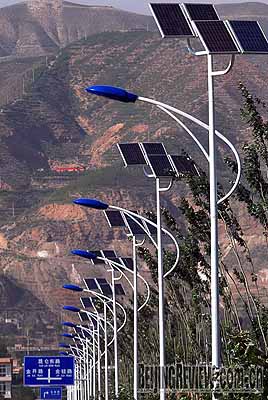| Hekou Village in Beijing's Fangshan District is famous for being close to the discovery site of prehistoric Peking Man, a predecessor to modern humans. Rated among Beijing's 10 Most Beautiful Villages in 2008, Hekou Village is noted not only for its appealing scenery, but also for its "green" efforts. With funding from the Beijing Municipal Rural Affairs Commission, many road lamps and household lights in the village and other parts of Fangshan District are powered by solar cells. Solar panel-equipped road lamps have become a tourist attraction.
|

|
|
NATURAL LIGHT? Road lamps powered by solar cells are put into use on the streets of Xining, capital of Qinghai Province (YANG SHOUDE) | Green road lamps use light emitting diode (LED) technology. The lights are equipped with photovoltaic parts, solar cells and solar power controllers. When sunlight strikes the surface of special photoelectric materials, electrons are knocked loose from the atoms, creating voltage. Photovoltaic elements absorb sunlight during the day, convert solar energy into electricity and store it in solar cells. In the evening, the stored electricity is used to power the lights.
On sunny days, if exposed to the sun for two hours, a solar cell can store enough energy to power a light for the whole evening. A solar cell charged for four hours under sunlight can last five days. The road lamps are controlled by either the sun or electricity. Each year, a road lamp can save thousands of yuan (hundreds of U.S. dollars) in electricity costs. According to the Fangshan District Energy Office, a road lamp can be used for 18 years, saving 60,000 kwh of electricity and 40,000 yuan ($4,635) in electricity costs.
China is rich in solar energy. Beijing averages 2,750 hours of light a year. That amount of solar radiation equals 2.6 billion tons of standard coal equivalent. With current solar technology being able to capture about 10 percent of the total solar energy reaching the Earth, each year 260 millions tons of standard coal equivalent could be saved.
In recent years, Beijing has stepped up the development and utilization of clean energy. Solar energy was used extensively during the Beijing Olympics in 2008. The solar-powered hot water system in the Olympic Village reduced carbon dioxide emissions by 5,577 tons.
Thin-film solar cell
However, on rainy or cloudy days, the solar power devices do not work so well. Many such devices use conventional crystalline silicon cells. The crystalline silicon is like an array of glass. It can generate electricity only when sunlight beams straight down on it at almost a right angle. No electricity will be generated if the sunlight slants down at too low an angle.
It is complicated to produce conventional crystalline silicon. Only silicon with a purity of 99.9999 percent can be used to produce solar cells. High-precision equipment is needed to purify the material, and the purification process uses a lot of energy, making traditional solar cells costly to produce. Because of its high cost, low solar efficiency and strict requirement for shapes, the conventional crystalline silicon has not been used widely, said Zeng Xiangbo, a research fellow at the Institute of Semiconductors under the Chinese Academy of Sciences (CAS).
Now though, the thin-film solar cell has overcome many of the shortages seen in conventional solar cells and is being used more and more extensively. As it can convert a high percentage of weaker light into electric power, it can work well even on cloudy days. Thin-film solar cells are also easy to produce-no high-precision complicated equipment is needed and the silicon does not have to be 99.9999 percent pure.
Thin-film solar cells are produced by spreading a thin layer of semiconducting materials on low-cost hard backing such as glass coated with silicon dioxide or flexible backing like aluminum foil or stainless steel sheets. Silicon, aluminum and zinc coatings are added later.
The amount of silicon needed to produce a thin-film solar cell is only 1 percent of that needed to produce a crystaline silicon solar cell, said Shi Zhengrong, President and CEO of Suntech Power Co. Ltd., China's largest photovoltatic firm. The cost of silicon accounts for about 70 percent of the total cost of solar cell production. If both technologies are equally efficient, then thin-film solar cells can mean huge saving in production cost, Shi added.
If an ordinary house is covered with thin-film solar cells, more than enough electricity can be produced for home use, according to Wei Gang, a journalist with Beijing Science and Technology Weekly. The surplus electricity can be sold back to the electric grid. "In the future, each house can be an electric power station, and we can sit at home and make money by producing power," said Wei.
|
